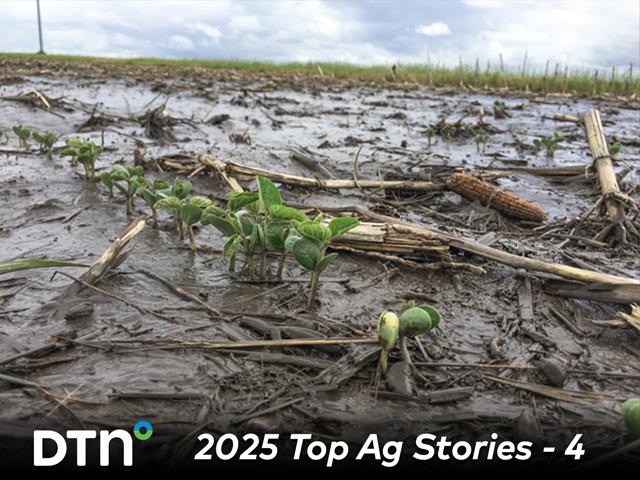Wetlands Case on Docket
South Dakota Farmer Asks Supreme Court for Help Over Wetlands Determination
OMAHA (DTN) -- The U.S. Supreme Court on Jan. 6 may decide whether it will hear a legal challenge to USDA's wetlands determination system filed by a South Dakota farmer last fall.
Miner County, South Dakota, farmer Arlen Foster petitioned the high court to consider whether a USDA procedure to determine wetlands on his 0.8 acre of land in the Prairie Pothole region is "arbitrary and capricious."
Last week, Foster's petition was distributed for review by the court at its Jan. 6 conference. Every year, the court holds multiple conferences to look at filed petitions. Typically, the court doesn't discuss every petition during those conferences. Those cases not discussed are considered to be denied.
Foster, who is represented by the Pacific Legal Foundation, told DTN in September that winter dumps piles of snow nearly every year along a tree belt near a 0.8-acre tract of land on his farm in the southeastern part of the state. Spring melt drains onto his field, often making it impossible to farm.
As a result, the 0.8 acre tract was declared a wetland based on a USDA process Foster asked the court to review. That process uses so-called reference sites when a tract of land being reviewed has been farmed, making it difficult to determine the presence of wetlands.
This month, USDA and attorneys for Foster filed briefs with the court on whether it should hear the case.
According to one estimate, http://bit.ly/…, the Supreme Court discusses maybe 20% to 25% of petitions distributed at a given conference.
The Pacific Legal Foundation asked the Supreme Court to consider a number of questions, including whether the use of a comparison site selected a decade ago to make the wetlands determination violates Foster's Fifth Amendment rights to due process.
USDA filed a response Dec. 7 in opposition to Foster's petition, http://bit.ly/….
P[L1] D[0x0] M[300x250] OOP[F] ADUNIT[] T[]
In the brief filed with the Supreme Court, USDA said it followed procedure in selecting the reference site when examining Foster's land.
"The agency had a preexisting list of sites that were undisturbed and therefore met the last regulatory requirement," the agency argued. "The site the agency ultimately chose was on that list. That does not mean that the agency simply chose a site from a preexisting list 'to determine the outcome of a contested question.' Rather, the agency considered all of the requirements in the regulation in choosing an appropriate reference site for Site 1, and one factor it considered was the requirement that the site be in its natural state."
Foster's attorneys filed a response to USDA on Dec. 19, http://bit.ly/….
"The Fosters consistently argued below that the use of a predetermined reference site, known to meet all wetland criteria, effectively foreclosed any possibility that the Fosters' property would not be found to be a wetland," according to the brief filed with the court.
"While the Fosters did not explicitly argue the due process clause in their briefing below, they clearly identified the element of the procedure that violates due process: the predetermination of the outcome. Due process requires a meaningful opportunity to be heard."
WETLANDS BACKLOG
The Natural Resources Conservation Service, or NRCS, has faced a backlog of requests for wetlands determinations. As a result, many landowners have been left waiting for years.
In Foster's situation, he said NRCS instead used a comparison site to make a determination. This deprives him of his rights, he contends in his appeal. Such comparisons are allowed by NRCS procedures.
Foster told DTN his pursuit has nothing to do with lost farm program dollars -- he hasn't even violated the Food Security Act that could lead to a loss of those resources, he said.
Rather, he said, he's carrying out a battle dating back to 2008 for the right to use his land as he sees fit. The farm produces corn, soybeans and hay, and he also raises cattle.
Foster said the NRCS didn't consider evidence the 0.8 acre tract is not an actual wetland. Instead, the NRCS deemed the land was similar to a known wetland more than 30 miles away.
The snow melt following consistent accumulation near the tree belt, Foster's attorneys argue in the petition to the high court, is the cause of consistent standing water on the land. It's something Foster said he should be allowed to repair.
In July 2008, Foster asked the NRCS to reconsider an earlier wetland delineation it performed, according to the petition. Foster continued to challenge NRCS through a series of court cases eventually losing an appeal to the U.S. Court of Appeals for the Eighth Circuit in St. Louis in April 2016.
The NRCS does not comment on pending litigation.
Wetland conservation provisions in the Food Security Act place no restrictions on farming wetlands if natural conditions allow for it. The wetlands provision prohibits converting wetlands to crop production by draining, filling or other means.
Read more about Foster v. Vilsack here: http://bit.ly/…
Todd Neeley can be reached at todd.neeley@dtn.com
Follow him on Twitter @toddneeleyDTN
(AG/BAS)
Copyright 2017 DTN/The Progressive Farmer. All rights reserved.



